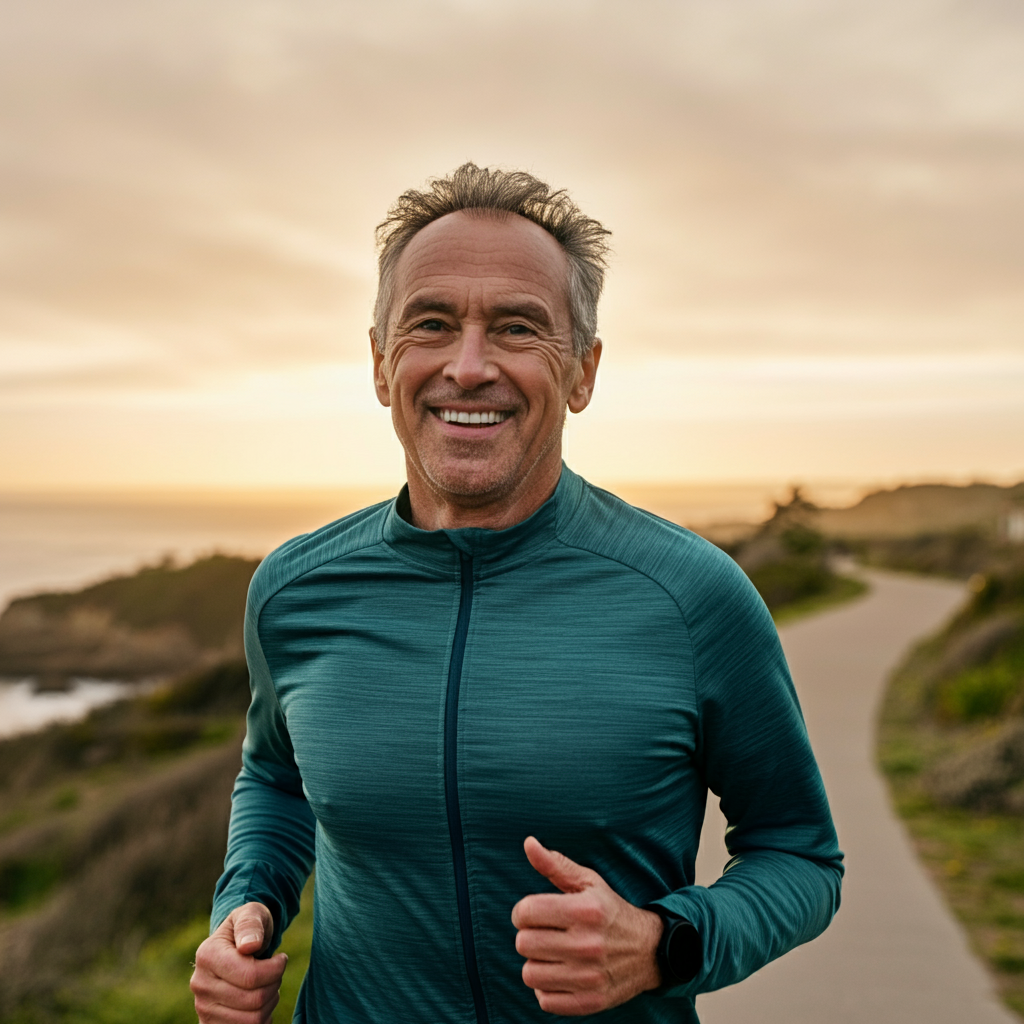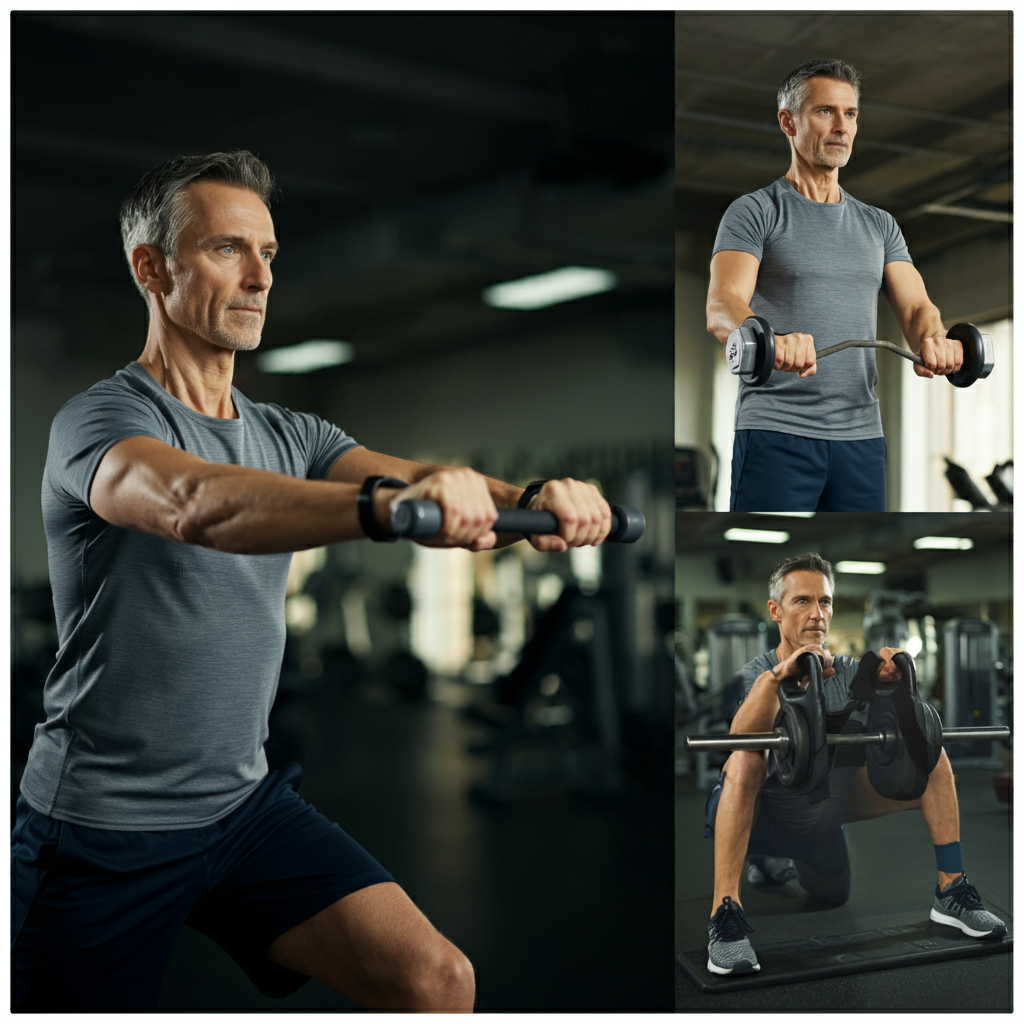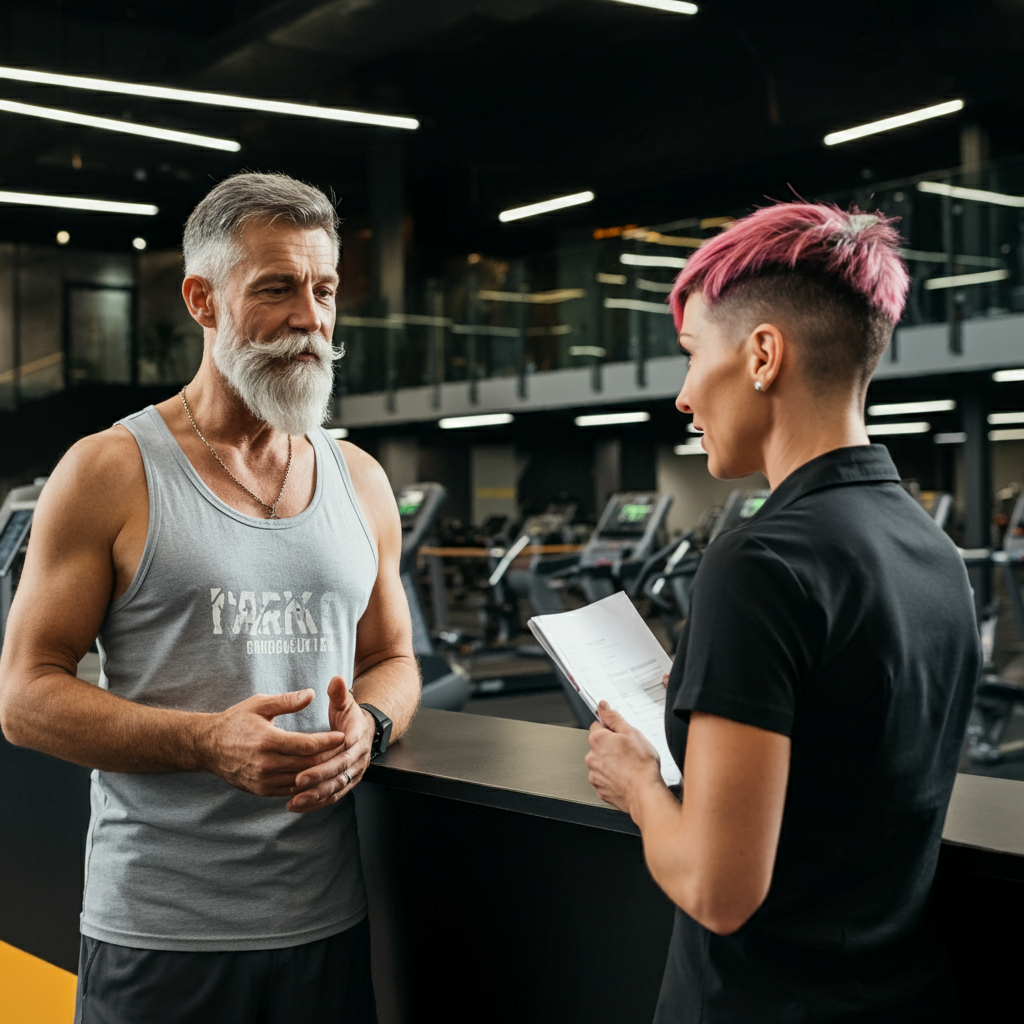Staying fit and healthy as we age isn’t just a goal – it’s a choice we make every day. Our bodies change over time, but that doesn’t mean we’re destined for decline.
Regular exercise and healthy habits can help maintain strength, flexibility, and overall well-being well into our later years.

The benefits of staying active are numerous. Physical activity can improve thinking skills, reduce anxiety, and keep our minds sharp. It also helps manage weight, strengthen bones and muscles, and lower the risk of many health conditions.
Making fitness a priority doesn’t have to be complicated.
Simple activities like walking, swimming, or gardening can make a big difference. The key is consistency and finding activities you enjoy.
Remember, it’s never too late to start taking care of your health.
Key Takeaways
- Regular physical activity improves both physical and mental health as we age
- Consistent exercise helps maintain strength, flexibility, and cognitive function
- Small, enjoyable activities done regularly can lead to significant health benefits

The Foundations of Aging and Health
Aging is a complex biological process that impacts physical and mental health. Understanding these changes and taking proactive steps can help maintain wellness as we grow older.
Understanding the Aging Process
As we age, our bodies undergo various changes at the cellular level. These changes affect organ function, metabolism, and overall health.
Bone density decreases, muscle mass diminishes, and cognitive function may decline.
The aging process also impacts the immune system, making older adults more susceptible to infections and diseases. Hormonal changes occur, affecting everything from sleep patterns to energy levels.
It’s crucial to recognize that while aging is inevitable, its effects can be moderated through lifestyle choices. Regular exercise, a balanced diet, and mental stimulation can slow down many age-related changes.
Critical Health Considerations as You Age
As individuals enter their later years, certain health aspects require special attention.
Cardiovascular health becomes increasingly important, as the risk of heart disease and stroke rises with age.
Bone health is another critical factor. Older adults should focus on maintaining strong bones through:
- Weight-bearing exercises
- Adequate calcium intake
- Vitamin D supplementation
Cognitive health deserves significant attention. Engaging in mentally stimulating activities, socializing, and learning new skills can help maintain brain function.
Regular health screenings become more crucial with age. These may include:
- Blood pressure checks
- Cholesterol tests
- Cancer screenings
- Vision and hearing tests

Lifestyle Choices and Longevity
Making smart lifestyle decisions can add years to one’s life. These choices have a big impact on health and wellness as people get older.
The Role of Physical Activity
Regular exercise is key for living longer. It helps keep the body strong and the mind sharp. Adults should aim for at least 150 minutes of moderate activity each week.
This can include:
- Brisk walking
- Swimming
- Cycling
- Strength training
Physical activity lowers the risk of many health problems. It can help prevent heart disease, diabetes, and some cancers. Exercise also boosts mood and brain function.
For older adults, balance exercises are important too. They help prevent falls and keep people independent longer.
Nutrition and Healthy Weight Management
Eating well is crucial for longevity. A balanced diet gives the body what it needs to work right. It should include lots of fruits, vegetables, whole grains, and lean proteins.
Some key nutrition tips:
- Limit processed foods
- Choose healthy fats like olive oil
- Eat more plant-based meals
- Stay hydrated
Keeping a healthy weight is also vital. Being too heavy or too thin can lead to health issues. A good goal is a BMI between 18.5 and 24.9.
Small changes can make a big difference. Eating smaller portions and moving more can help manage weight over time.

Mental Health and Emotional Well-Being
Exercise and physical activity play a crucial role in maintaining mental health as we age. They help combat mood disorders, reduce stress, and keep our brains sharp.
Combating Depression and Anxiety
Regular physical activity can be a powerful tool in fighting depression and anxiety. Exercise improves brain health and reduces the risk of these mood disorders. It boosts feel-good chemicals in the brain, such as endorphins and serotonin.
For those dealing with depression, a consistent exercise routine can be as effective as medication in some cases. Even short bursts of activity, like a 10-minute walk, can lift mood and energy levels.
Anxiety symptoms often decrease with regular physical activity. Exercise helps shift focus away from worries and promotes a sense of calm. It also improves sleep quality, which is crucial for managing anxiety.
Stress Relief through Exercise
Physical activity is a natural stress-buster. When faced with stressors, the body releases cortisol, the “stress hormone”. Exercise helps regulate cortisol levels, leading to better stress management.
Aerobic activities like jogging or swimming are particularly effective for stress relief. They promote relaxation and improve overall well-being.
Even gentler forms of movement, such as yoga or tai chi, can significantly reduce stress.
Regular exercise also boosts self-confidence and provides a sense of accomplishment. These positive feelings can help buffer against daily stressors and improve overall quality of life.
Cognitive Function and Brain Health
Physical activity is like a workout for the brain. It enhances cognitive function and protects against age-related mental decline. Exercise improves memory, attention, and decision-making skills.
Regular aerobic exercise increases blood flow to the brain, promoting the growth of new brain cells. This process, called neurogenesis, is particularly important in areas related to memory and learning.
Activities that combine physical and mental challenges, like dancing or tennis, offer added cognitive benefits. They improve coordination and reaction time while engaging multiple brain areas.
For older adults, staying physically active can reduce the risk of dementia and Alzheimer’s disease. Even moderate exercise, like brisk walking, can have significant protective effects on brain health.

Physical Fitness Regimens for Adults
Regular exercise is crucial for adults to maintain health and vitality as they age. A well-designed fitness program incorporates strength training, cardiovascular exercise, and flexibility work to maximize overall wellness.
Developing a Balanced Routine
A balanced fitness routine should include aerobic activity, resistance training, and flexibility exercises.
Adults should aim for at least 150 minutes of moderate-intensity aerobic exercise or 75 minutes of vigorous-intensity aerobic exercise per week.
Resistance training should be performed 2-3 times per week, targeting all major muscle groups. This can include bodyweight exercises, free weights, or resistance bands.
Flexibility work, such as stretching or yoga, should be done daily to maintain range of motion and prevent injuries.
Here’s a sample weekly routine:
- Monday: 30 min cardio, 30 min strength training
- Tuesday: 45 min yoga
- Wednesday: 30 min cardio, 30 min strength training
- Thursday: Rest or light activity
- Friday: 30 min cardio, 30 min strength training
- Saturday: 60 min recreational activity (e.g. hiking, cycling)
- Sunday: Rest or light activity
Strength Training and Its Significance
Strength training is essential for maintaining muscle mass and bone density as adults age. It helps prevent sarcopenia (age-related muscle loss) and osteoporosis.
Key exercises to include:
- Squats or leg press
- Chest press or push-ups
- Rows or pull-ups
- Shoulder press
- Deadlifts or hip hinges
Start with 2-3 sets of 8-12 repetitions for each exercise. Gradually increase weight or resistance as strength improves.
Proper form is crucial to prevent injuries. Adults new to strength training should consider working with a certified fitness professional to learn correct techniques.

Incorporating Cardiovascular Workouts
Cardiovascular exercise is vital for heart health and reduces the risk of chronic diseases. It improves endurance, helps maintain a healthy weight, and boosts mood.
Effective cardio options include:
- Brisk walking
- Jogging or running
- Swimming
- Cycling
- Rowing
Adults should start with shorter sessions and gradually increase duration and intensity. High-intensity interval training (HIIT) can be an efficient way to improve cardiovascular fitness in less time.
It’s important to choose activities that are enjoyable and sustainable. This increases the likelihood of long-term adherence to a fitness program.
Risks Associated with Inactivity
Not moving enough can harm your health. Being inactive raises your chances of getting sick and gaining weight. Let’s look at some specific risks.
Chronic Diseases and Sedentary Lifestyle
A sedentary lifestyle increases the risk of many chronic diseases. People who don’t exercise are more likely to get heart disease, even when other factors are considered.
Lack of activity can lead to:
- Higher blood pressure
- Increased cholesterol levels
- Greater chance of stroke
- Higher risk of type 2 diabetes
Physical inactivity is a leading cause of death worldwide. Those who don’t move enough have a 20-30% higher risk of dying compared to active people.
Weight Gain and Related Health Issues
When someone doesn’t move much, they burn fewer calories. This often leads to weight gain over time. Extra weight raises the risk of obesity and related problems.
Obesity linked to inactivity can cause:
- Joint pain
- Sleep apnea
- Breathing difficulties
- Increased cancer risk
Low energy expenditure from being inactive makes it hard to maintain a healthy weight. This creates a cycle where weight gain makes exercise harder, leading to more inactivity.
Regular movement is key for keeping a healthy weight and avoiding these issues. Even small amounts of activity can help reduce these risks.

Optimizing Health through Proper Sleep
Sleep plays a crucial role in maintaining health as we age. Getting enough quality sleep can improve cognitive function, physical performance, and emotional well-being.
Sleep Quality and Its Impact on Health
Good sleep is essential for optimal health at every stage of life. As people age, their sleep needs change. Adults typically require 7-9 hours of sleep per night.
Poor sleep quality can lead to various health issues. It may increase the risk of heart disease, diabetes, and dementia. On the other hand, consistently good sleep can boost immune function and help regulate hormones.
To improve sleep quality, individuals should establish a regular sleep schedule. This means going to bed and waking up at the same time each day, even on weekends.
Creating a relaxing bedtime routine can also enhance sleep. This might include reading a book, taking a warm bath, or practicing gentle stretches.
Exercise can significantly improve sleep quality. Regular physical activity helps people fall asleep faster and enjoy deeper, more restorative sleep. However, it’s best to avoid vigorous exercise close to bedtime.
A sleep-friendly environment is key. The bedroom should be dark, quiet, and cool. Comfortable bedding and pillows can make a big difference in sleep quality.
Limiting screen time before bed is crucial. The blue light from devices can interfere with the body’s natural sleep-wake cycle.
Prevention and Management of Health Conditions
Regular physical activity plays a crucial role in preventing and managing various health conditions as we age. It offers a powerful defense against common age-related issues and can significantly improve quality of life.
Cardiovascular Health and Activity Levels
Physical activity provides substantial benefits for heart health. It helps lower blood pressure and reduces the risk of heart disease and stroke. Even moderate exercise, like brisk walking for 30 minutes a day, can make a difference.
For optimal cardiovascular health, adults should aim for at least 150 minutes of moderate-intensity aerobic activity per week. This can include activities such as:
- Swimming
- Cycling
- Dancing
- Brisk walking
These exercises strengthen the heart muscle and improve circulation. They also help maintain healthy cholesterol levels and reduce inflammation in the body.
Mitigating Risks of Osteoporosis and Arthritis
Weight-bearing exercises and resistance training are essential for maintaining bone density and joint health. These activities help prevent osteoporosis and manage arthritis symptoms.
Effective exercises for bone and joint health include:
- Weightlifting
- Yoga
- Tai chi
- Hiking
These activities improve balance and flexibility, reducing the risk of falls. They also strengthen the muscles around joints, providing better support and reducing pain.
For those with arthritis, low-impact exercises like swimming or water aerobics can be particularly beneficial. They allow for movement without putting excess stress on the joints.
Physical Activity’s Role in Cancer Prevention
Regular physical activity can help reduce the risk of several types of cancer. It does this by improving immune function, reducing inflammation, and helping maintain a healthy weight.
Studies have shown that exercise can lower the risk of:
- Colon cancer
- Breast cancer
- Endometrial cancer
The American Cancer Society recommends adults get 150-300 minutes of moderate-intensity exercise or 75-150 minutes of vigorous-intensity exercise per week. This can be achieved through a combination of aerobic activities and strength training.
Physical activity also helps cancer survivors manage treatment side effects and improve their overall quality of life. It can reduce fatigue, improve mood, and enhance physical function during and after cancer treatment.

The Spectrum of Physical Activities
Physical activity comes in many forms, offering options for people of all fitness levels and abilities. From gentle movements to intense workouts, there’s something for everyone to improve health and well-being.
Low to Moderate Activities for Everyone
Walking is a great low-impact activity that almost anyone can do. It’s easy on the joints and can be done anywhere. Aim for 30 minutes of brisk walking most days of the week.
Swimming is another excellent option. It’s gentle on the body while providing a full-body workout. Water aerobics classes are fun and social alternatives for those who prefer group activities.
Cycling, either outdoors or on a stationary bike, is a moderate-intensity aerobic activity that improves cardiovascular health. Start with short rides and gradually increase duration and intensity.
High-Intensity Workouts for the Eager
For those seeking more challenge, high-intensity interval training (HIIT) offers significant benefits in less time. HIIT involves short bursts of intense exercise followed by brief rest periods.
Running is a classic vigorous-intensity physical activity. It burns calories efficiently and strengthens bones. Proper footwear and gradual progression are key to avoid injury.
Strength training with weights or resistance bands builds muscle mass and bone density. It’s crucial for maintaining strength and function as we age.
Flexibility and Balance Exercises
Yoga combines strength, flexibility, and balance training. It also reduces stress and improves mental well-being. Many styles exist, from gentle to more vigorous practices.
Tai chi, an ancient Chinese practice, enhances balance and body awareness. Its slow, flowing movements are particularly beneficial for older adults.
Dancing is a fun way to improve flexibility and coordination. It also provides social interaction, which is important for mental health.
Stretching exercises should be part of any fitness routine. They improve flexibility, reduce muscle tension, and help prevent injuries.

Guidelines and Recommendations
Physical activity guidelines provide a roadmap for staying fit as we age. They offer evidence-based recommendations for different age groups and health conditions. Let’s explore key guidelines and how to adapt them to individual needs.
WHO and National Guidelines
The Physical Activity Guidelines for Americans set clear targets for adults. They suggest 150-300 minutes of moderate-intensity or 75-150 minutes of vigorous-intensity aerobic activity per week. Strength training for all major muscle groups is recommended twice weekly.
WHO guidelines align closely with these recommendations. They emphasize the importance of reducing sedentary time for all age groups. For older adults, WHO adds balance and strength training to prevent falls.
These guidelines are based on extensive research showing the health benefits of regular physical activity. They aim to reduce the risk of chronic diseases and improve overall quality of life.
Tailoring Activities to Individual Needs
While guidelines provide a general framework, it’s crucial to adapt them to individual circumstances. Factors like current fitness level, health conditions, and personal preferences should shape one’s exercise routine.
For those new to exercise, starting slowly and gradually increasing intensity is key. They might begin with short walks or gentle stretching. As fitness improves, they can add more challenging activities.
People with chronic conditions should consult healthcare providers to tailor activities safely. For instance, those with arthritis might focus on low-impact exercises like swimming or cycling.
The goal is to find enjoyable activities that fit into daily life. This might mean moderate- to vigorous-intensity physical activity spread throughout the day in short bursts, rather than long sessions.

Staying Active in the Community
Engaging in community activities promotes physical and mental well-being as we age. It fosters social connections and provides opportunities for regular exercise.
Group Sports and Social Engagement
Group sports offer a fun way to stay active and socialize. Soccer and tennis are excellent options for older adults. These sports improve cardiovascular health and coordination.
Soccer builds leg strength and endurance. It’s adaptable for various fitness levels. Walking soccer is a low-impact alternative for those with mobility issues.
Tennis enhances hand-eye coordination and balance. It’s a lifelong sport that can be played well into later years. Doubles tennis is particularly social and less physically demanding.
Cycling groups are popular among older adults. They offer a low-impact workout that’s easy on the joints. Group rides foster camaraderie and explore local areas.
Community Resources and Programs
Local community centers often offer fitness classes tailored for older adults. These may include yoga, tai chi, or water aerobics. Such programs are designed to improve flexibility, balance, and strength.
Walking clubs are an excellent way to stay active. They require no special equipment and suit various fitness levels. Regular walks improve cardiovascular health and boost cognitive function.
Many communities have senior-specific fitness facilities. These gyms provide age-appropriate equipment and knowledgeable staff. They often offer group classes and personalized training programs.
Volunteering is another way to stay active. It combines physical activity with social engagement. Options might include gardening in community parks or assisting at local events.

Frequently Asked Questions
Staying healthy as we age requires purposeful choices and habits. Physical activity, lifestyle factors, and proactive health management all play key roles in promoting longevity and vitality in our later years.
What are the top ten strategies for promoting healthy aging?
- Exercise regularly, including both cardio and strength training
- Eat a balanced, nutrient-dense diet
- Get adequate sleep (7-9 hours per night)
- Manage stress through meditation or other relaxation techniques
- Stay socially connected with friends and family
- Challenge your brain with new learning and activities
- Get regular health screenings and checkups
- Maintain a healthy weight
- Don’t smoke and limit alcohol intake
- Protect your skin from sun damage
How does regular physical activity benefit seniors?
Regular exercise helps seniors maintain muscle mass, bone density, and balance. It reduces the risk of falls and fractures. Physical activity also boosts cognitive function and mood.
Exercise can help manage chronic conditions like arthritis, diabetes, and heart disease. It also improves sleep quality and overall energy levels in older adults.
What are the key factors to consider for aging healthily?
Diet plays a crucial role in healthy aging. Seniors should focus on eating plenty of fruits, vegetables, lean proteins, and whole grains. Staying hydrated is also important.
Regular medical check-ups help catch and manage health issues early. Seniors should stay up-to-date on recommended screenings and vaccinations.
What are the indicators of successful aging?
Physical independence in daily activities is a key sign of successful aging. This includes being able to dress, bathe, and move around without assistance.
Cognitive function, including memory and problem-solving skills, is another important indicator. Emotional well-being and social engagement also play vital roles.
How should one alter their fitness routine as they get older?
As we age, low-impact exercises become more important. Activities like swimming, cycling, and yoga are gentler on the joints.
Strength training remains crucial but should be done with proper form and lighter weights if needed. Balance exercises help prevent falls.
What lifestyle choices contribute to a healthy and active life in older age?
Staying mentally active supports cognitive health. You can do this by learning new skills or hobbies. Reading, puzzles, and social activities all help keep the mind sharp.
Maintaining strong social connections reduces the risk of depression and cognitive decline. You can do this by volunteering or joining clubs. These activities can provide meaningful social engagement.
- PowerBlock Elite EXP Dumbbells Review: Are They Worth It? - November 5, 2024
- On the Edge of a Revolution? Eric Weinstein’s Raw Take on What’s Coming - November 5, 2024
- Why Isn’t Anyone Talking About This? Dr. Eric Berg’s Bold Take on Nutrition - November 5, 2024








